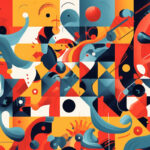Storytelling has been a part of our lives for as long as we can remember. It is a way of conveying experiences, emotions, and ideas that can transcend cultures, time, and space. Whether we are hearing about a mythical hero’s journey or reading a business case study, stories are a powerful tool for communicating and connecting with others. In this article, we will explore the best books on storytelling that can help you improve your own storytelling skills, learn more about the science behind storytelling, and discover how to use storytelling in business and marketing.

The Power of Storytelling in Our Lives
Before we delve into specific books on storytelling, let’s first understand why stories matter in the first place.
Why Stories Matter
Stories have always been a fundamental part of human communication. They offer a way of sharing experiences, emotions, and ideas that can be more memorable and persuasive than just presenting facts. Stories can help us relate to others, build empathy, and even change our perspectives. For example, a story about a family’s struggle to survive during a natural disaster can help us understand the challenges faced by people in similar situations, and inspire us to take action to help.
Moreover, stories have been used as a tool for social and cultural preservation throughout history. From ancient civilizations to modern times, stories have been passed down from generation to generation, preserving cultural values, traditions, and beliefs. They offer a glimpse into the past and provide insight into the way people used to live, think, and feel.
The Science Behind Storytelling
While storytelling has been around for millennia, recent research has shed light on why our brains are wired to respond so strongly to stories. It turns out that when we hear a story, our brains release oxytocin, a hormone that is associated with social bonding and empathy. This chemical response can help to create a sense of connection between the storyteller and the audience, and can make the messages conveyed through the story more persuasive and memorable.
Additionally, stories activate different parts of our brain, including the visual, auditory, and sensory cortex, which means that they can be more engaging and stimulating than other forms of communication. This is why stories are often used in advertising and marketing to capture people’s attention and promote products or services.
Now that we’ve explored why stories matter and how they affect our brains, let’s dive into the best books on storytelling that can help you become a better storyteller.
The Best Books on Storytelling
There are countless books on storytelling out there, but here are a few that stand out:
The Anatomy of Story by John Truby
This book offers a comprehensive guide to storytelling, covering everything from character development to plot structure.
You can find this book here.
The Hero with a Thousand Faces by Joseph Campbell
This classic book explores the concept of the hero’s journey and how it has been used in myths, legends, and stories throughout history.
You can find this book here.
On Writing by Stephen King
This memoir and writing guide offers insights into King’s writing process and tips for aspiring writers.
You can find this book here.
The Storyteller’s Secret by Carmine Gallo
This book examines the power of storytelling in business and offers practical advice for using stories to inspire and motivate employees, customers, and stakeholders.
You can find this book here.
Whether you’re a writer, a marketer, or just someone who wants to become a better storyteller, these books can help you hone your skills and tap into the power of storytelling.
Classic Books on Storytelling
The art of storytelling has been around for centuries, with countless tales told and retold throughout history. Whether it’s myths, fairy tales, or modern novels, effective storytelling has the power to transport us to new worlds, evoke powerful emotions, and inspire us to think about the world in new ways. The following books are considered timeless classics on the subject of storytelling:
The Hero with a Thousand Faces by Joseph Campbell
In this book, Campbell explores the concept of the archetypal hero’s journey that is found in myths and stories from around the world. He argues that all great stories follow a similar pattern, with the hero facing challenges and obstacles before ultimately achieving a goal or overcoming a great evil. By examining the common themes and motifs in these stories, Campbell provides a framework for understanding the fundamental elements of effective storytelling.
For example, in the classic Greek myth of Theseus and the Minotaur, Theseus must journey into the labyrinth to slay the monstrous Minotaur and save his people. Along the way, he faces numerous challenges and setbacks, but ultimately emerges victorious and returns home a hero. This story follows the archetypal hero’s journey, and Campbell’s book provides a fascinating analysis of this and other similar stories from cultures around the world.
You can find this book here.
The Uses of Enchantment by Bruno Bettelheim
Bettelheim’s book offers a psychoanalytic perspective on fairy tales, arguing that these stories offer a way for children to explore and understand their own emotions and psychological struggles. He believes that fairy tales provide a safe space for children to grapple with difficult emotions and experiences, and that the symbolic language of these stories can help children make sense of their inner world.
For example, in the classic fairy tale of Cinderella, the stepmother and stepsisters represent the oppressive forces in Cinderella’s life, while the fairy godmother represents the power of transformation and the possibility of change. By analyzing the symbolism and themes in classic fairy tales, Bettelheim provides a deeper understanding of the power of storytelling to help us make sense of our lives.
You can find this book here.
The Anatomy of Story by John Truby
Truby’s book offers a comprehensive guide to storytelling, including tips on developing compelling characters, creating a strong plot, and crafting effective dialogue. Drawing on his decades of experience as a screenwriter and story consultant, Truby provides practical advice for writers of all genres.
Truby emphasizes the importance of creating complex and multi-dimensional characters, with their own unique motivations, flaws, and desires. He also stresses the importance of creating a strong plot that keeps readers engaged and invested in the story. Finally, Truby offers tips on crafting effective dialogue that sounds natural and authentic, while also advancing the plot and revealing important information about the characters.
Overall, these three classic books on storytelling offer valuable insights and techniques for writers and readers alike. Whether you’re interested in myths, fairy tales, or modern novels, these books provide a framework for understanding the power of storytelling to inspire, entertain, and enlighten us.
You can find this book here.
Books on Storytelling Techniques
The art of storytelling is a craft that has been honed over centuries. From the earliest cave paintings to the latest blockbuster movies, storytelling has been an essential part of human culture. The following books focus on specific techniques and approaches to storytelling:
Save the Cat! by Blake Snyder
This book, aimed primarily at screenwriters, offers a formulaic approach to developing compelling stories. Snyder’s “beat sheet” provides a template for plotting out a story, ensuring that it has a clear and effective structure. The book is divided into three parts, with the first part focusing on the basics of storytelling, the second part on the structure of a screenplay, and the third part on the business of screenwriting. Snyder’s approach is both practical and entertaining, making it a must-read for anyone interested in screenwriting.
Snyder’s approach has been widely adopted in Hollywood, with many successful films following his beat sheet formula. However, some critics argue that his approach can lead to formulaic and predictable stories. Regardless of this criticism, Save the Cat! remains a popular and influential book in the world of screenwriting.
Story by Robert McKee
McKee’s book is another classic in the world of storytelling, offering an in-depth exploration of the principles and techniques of effective storytelling. Drawing on examples from both classic literature and contemporary film, McKee offers practical advice on everything from character development to dialogue. The book is divided into three parts, with the first part focusing on the art of storytelling, the second part on the principles of story design, and the third part on the techniques of storytelling.
McKee’s approach is highly analytical, and his book is often used as a textbook in film schools. However, the book is also accessible to non-professionals, providing a comprehensive guide to the art of storytelling. McKee’s book has been praised for its clarity and depth, making it a valuable resource for anyone interested in storytelling.
You can find this book here.
The Writer’s Journey by Christopher Vogler
Vogler’s book takes inspiration from Joseph Campbell’s “hero’s journey” and applies it to screenwriting and storytelling. By breaking down the archetypal elements of the hero’s journey, Vogler provides a framework for creating compelling stories that resonate with audiences. The book is divided into three parts, with the first part focusing on the hero’s journey, the second part on the tools of the trade, and the third part on the practical application of the hero’s journey.
Vogler’s approach has been widely adopted in Hollywood, with many successful films following his hero’s journey formula. However, some critics argue that his approach can lead to formulaic and predictable stories. Regardless of this criticism, The Writer’s Journey remains a popular and influential book in the world of screenwriting and storytelling.
Overall, these three books offer valuable insights into the art and craft of storytelling. Whether you’re a professional screenwriter or a hobbyist storyteller, these books provide practical advice and inspiration for creating compelling stories that captivate audiences.
Storytelling in Business and Marketing
The following books focus specifically on the use of storytelling in business and marketing:
Made to Stick by Chip and Dan Heath
In this book, the Heath brothers explore the characteristics of “sticky” ideas – ideas that are particularly memorable and effective at communicating a message. Using real-world examples, they provide practical advice on how to craft stories and messages that are more likely to stick in the minds of your audience.
You can find this book here.
The Story Factor by Annette Simmons
Simmons’ book argues that storytelling is a key tool for influencing others, particularly in the context of business and leadership. By providing examples and exercises for developing storytelling skills, Simmons offers a way to become more persuasive and effective in your communication.
You can find this book here.
Building a StoryBrand by Donald Miller
Miller’s book offers a unique approach to using storytelling in marketing, by helping businesses to create a clear and compelling brand story. By focusing on the needs and desires of the customer, Miller argues, businesses can create a story that resonates with their audience and drives sales.
You can find this book here.
Whether you are a writer, marketer, or simply a lover of stories, these books on storytelling offer valuable insights and techniques for improving your storytelling skills and creating more effective communication. By understanding the power of storytelling and learning from the best, you can become a more compelling storyteller and connect more deeply with others.
- The 11 Best Books About Cats You Should Read - January 16, 2024
- The 9 Best Books on Building Confidence - January 16, 2024
- Discover the 10 Best Books on the Brain - January 16, 2024







